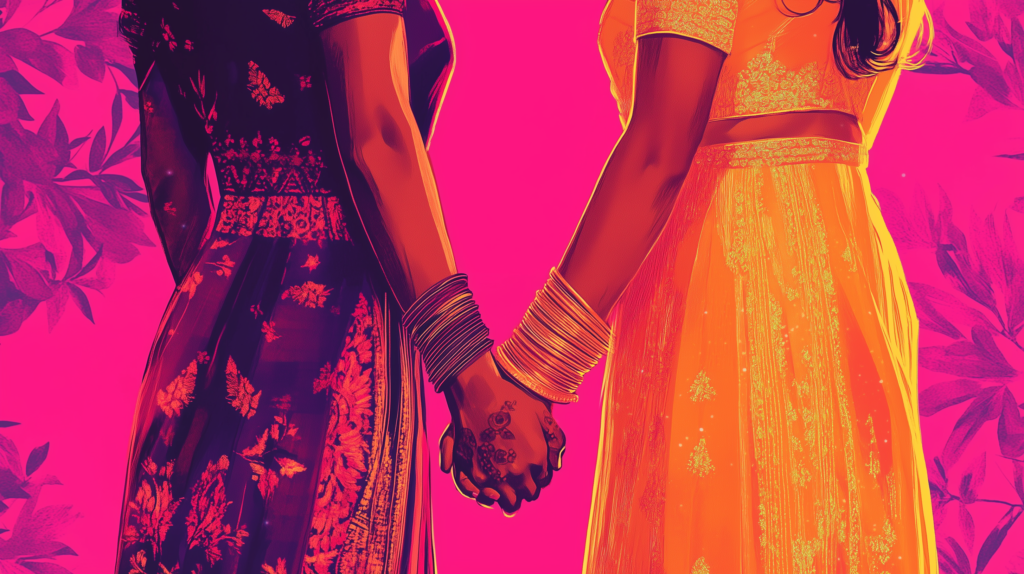“There’s no word in our language that can describe what we are. How we feel for each other. I desire Sita; I desire her warmth and her compassion. I desire to live again,” confesses Radha in the 1996 film Fire by Deepa Mehta. This poignant line from one of the earliest mainstream Bollywood films to explicitly portray homosexual relations speaks volumes about the underexplored theme of sapphic romance in Bollywood.
In contemporary usage, sapphic refers to women who are attracted to other women, encompassing lesbian, bisexual, queer, and trans identities. While Western media has made significant strides in representing diverse same-sex relationships, Bollywood has been more tentative, offering only a few glimpses into sapphic or sapphic-coded relationships. However, the demand for diverse narratives that reflect the complexities of love beyond heteronormative conventions is pushing the Indian film industry toward more inclusive storytelling.
Pioneering Representation: Fire (1996)
Fire stands as a groundbreaking example of sapphic romance in Bollywood. The film tells the story of two sisters-in-law, Sita (Nandita Das) and Radha (Shabana Azmi), trapped in loveless marriages, who develop a deep emotional and physical bond. Radha’s husband, Ashok, follows an abstinent lifestyle based on religious principles, leaving their marriage sexless for over a decade. Meanwhile, Sita’s husband, Jatin, continues to date another woman while conforming to societal expectations by marrying Sita. As the two women seek solace in each other, their bond transforms into a secret love affair.
When their relationship is discovered, Radha ultimately finds the strength to leave her oppressive marriage and reunites with Sita, choosing love and personal freedom. The film’s release in India in 1998 sparked protests from far-right groups, who claimed it was a threat to Indian culture and values. Despite the backlash, Fire became a pivotal moment for LGBTQ+ representation in Bollywood, challenging traditional norms and bringing sapphic romance into the public conversation.
Subtext and Subtlety: Dedh Ishqiya (2014)
Another noteworthy entry in the sapphic romance genre is Dedh Ishqiya (2014), a film that subtly weaves sapphic undertones into its narrative. The story centers on Begum Para (Madhuri Dixit) and her maid Muniya (Huma Qureshi), whose relationship is portrayed with deep emotional intimacy and suggestive dialogue. While the film never explicitly states that the two women are in a romantic relationship, their bond allows for interpretation through a sapphic lens.
The subtle handling of this relationship showcases Bollywood’s capacity for nuanced storytelling, especially within the constraints of cultural sensitivities.
The dynamic between Begum and Muniya adds layers of complexity to the film, highlighting the unspoken desires that often accompany sapphic-coded relationships in Indian cinema.
Unspoken Desires: Parched (2015)
Parched (2015) further explores sapphic coding through the story of four women living in a patriarchal village. Rani, Janki, Lajjo, and Bijli navigate forced marriages, abuse, and societal expectations while forging deep connections with each other. In one notable scene, Rani (Tannishtha Chatterjee) and Lajjo (Radhika Apte) share an intimate moment that hints at a deeper, possibly romantic connection.
The film’s portrayal of female desire and the unspoken emotions between women adds another dimension to its narrative.
By focusing on the complexities of their relationships, Parched highlights the way women in oppressive societies can find strength and solace in each other, further contributing to the subtle exploration of sapphic themes in Bollywood.
The Explicit Turn: Ek Ladki Ko Dekha Toh Aisa Laga (2019)
In 2019, Bollywood took a more explicit approach to sapphic romance with Ek Ladki Ko Dekha Toh Aisa Laga. The film centers on Sweety (Sonam Kapoor), a young woman struggling to come out to her conservative Punjabi family. Sweety’s relationship with another woman, Kuhu, is the heart of the story, which unfolds as Sweety enlists the help of a playwright, Sahil, to express her truth through a play.
The film openly discusses same-sex love and the challenges faced in a traditional society. Unlike previous films that relied on subtext,
Ek Ladki Ko Dekha Toh Aisa Laga boldly brings sapphic romance to the forefront of its narrative, offering a much-needed representation of LGBTQ+ relationships in Bollywood.
The film’s positive reception marked a step forward for Bollywood, signaling a gradual acceptance of diverse love stories.
A Complex Parallel: Alicent and Rhaenyra in House of the Dragon
While Bollywood has only recently begun exploring sapphic romance in a more overt way, comparisons can be drawn to relationships in Western media, such as the complex bond between Alicent Hightower and Rhaenyra Targaryen in HBO’s House of the Dragon. Though not explicitly sapphic, their relationship is filled with emotional intensity and underlying tensions, which fans have interpreted as sapphic-coded.
This dynamic mirrors many sapphic-coded relationships in Bollywood, where deep emotional connections and unspoken desires are woven into narratives without overtly defining them as romantic.
As seen in films like Dedh Ishqiya, Bollywood often leaves room for interpretation, allowing viewers to see these relationships through a sapphic lens.
The Road Ahead: A Gradually Transforming Bollywood
As Bollywood continues to evolve, sapphic romance is slowly gaining recognition. Films like Fire and Ek Ladki Ko Dekha Toh Aisa Laga have paved the way for future stories that explore the full spectrum of human relationships. While explicit sapphic romances remain rare, the growing presence of sapphic-coded relationships suggests a promising shift in Indian cinema.
By normalizing sapphic relationships in mainstream Bollywood, these films contribute to a broader cultural conversation about love, acceptance, and equality. As more filmmakers tackle these themes, Bollywood has the potential to play a crucial role in dismantling stereotypes and promoting inclusivity, offering audiences a richer and more diverse understanding of love.
The journey toward greater representation is far from over, but the road ahead is filled with possibilities. With each new film that explores sapphic romance or sapphic-coded relationships, Bollywood inches closer to a more inclusive and compassionate portrayal of the diverse ways in which people experience love.
